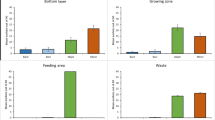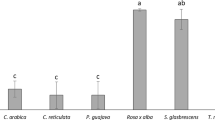Abstract
Abstract In a foraging column of the leaf-cutting ant Atta cephalotes, minim workers (the smallest worker subcaste) “hitchhike” on leaf fragments carried by larger workers. It has been demonstrated that they defend leaf carriers against parasitic phorid flies. The present study examines the cues used by the potential hitchhikers to locate leaf carriers. As recently reported, foraging workers stridulate while cutting a leaf fragment, and the stridulatory vibrations serve as closerange recruitment signals. We tested the hypothesis that these plant-borne stridulatory vibrations are used by the potential hitchhikers to locate workers engaged in cutting. Three different lines of evidence support this view. Firstly, the repetition rate of the stridulations produced by foraging workers increases significantly as foragers maneuver the leaf fragment into the carrying position and walk loaded to the nest. This is the moment when hitchhikers usually climb on the leaf. Although the leaf-borne stridulatory vibrations are considerably attenuated when transmitted through the workers' legs, they can nevertheless be detected at short distances by minims. This subcaste is several times more sensitive to substrate-borne vibrations than larger workers. Secondly, when a “stridulating” and a “silent” leaf were simultaneously presented at the foraging site, minim workers spent significantly more time on the stridulating than on the silent leaf. Thirdly, hitchhiking was more frequent in leaf carriers which cut fragments out of the stridulating leaf than in those cutting the silent leaf.Abstract In a foraging column of the leaf-cutting ant Atta cephalotes, minim workers (the smallest worker subcaste) “hitchhike” on leaf fragments carried by larger workers. It has been demonstrated that they defend leaf carriers against parasitic phorid flies. The present study examines the cues used by the potential hitchhikers to locate leaf carriers. As recently reported, foraging workers stridulate while cutting a leaf fragment, and the stridulatory vibrations serve as closerange recruitment signals. We tested the hypothesis that these plant-borne stridulatory vibrations are used by the potential hitchhikers to locate workers engaged in cutting. Three different lines of evidence support this view. Firstly, the repetition rate of the stridulations produced by foraging workers increases significantly as foragers maneuver the leaf fragment into the carrying position and walk loaded to the nest. This is the moment when hitchhikers usually climb on the leaf. Although the leaf-borne stridulatory vibrations are considerably attenuated when transmitted through the workers' legs, they can nevertheless be detected at short distances by minims. This subcaste is several times more sensitive to substrate-borne vibrations than larger workers. Secondly, when a “stridulating” and a “silent” leaf were simultaneously presented at the foraging site, minim workers spent significantly more time on the stridulating than on the silent leaf. Thirdly, hitchhiking was more frequent in leaf carriers which cut fragments out of the stridulating leaf than in those cutting the silent leaf.
Similar content being viewed by others
References
Baroni-Urbani C, Buser MW, Schilliger E (1988) Substrate vibration during recruitment in ant social organization. Insectes Soc 35:241–250
Cherrett JM (1968) The foraging behaviour of Atta cephalotes L. (Hymenoptera: Formicidae). I. Foraging patterns and plant species attacked in tropical rain forest. J Anim Ecol 37:387–403
Cherrett JM (1972) Some factors involved in the selection of vegetable substrate by Atta cephalotes (L.) (Hymenoptera: Formicidae) in tropical rain forest. J Anim Ecol 41:647–660
Daguerre JB (1945) Hormigas del género Atta Fabricius de la Argentina. Rev Soc Arg Entomol 12:438–460
Eibl-Eibesfeldt I, Eibl-Eibesfeldt E (1967) Das Parasitenabwehren der Minima-Arbeiterinnen der Blattschneider-Ameise (Atta cephalotes). Z Tierpsychol 24:278–281
Feener DH Jr, Moss KAG (1990) Defense against parasites by hitchhikers in leaf-cutting ants: a quantitative assessment. Behav Ecol Sociobiol 26:17–29
Gordon DM (1989) Caste and change in social insects. In: Harvey PH, Partridge L (eds) Oxford surveys in evolutionary biology, vol 6. Oxford University Press, Oxford, pp 55–72
Hahn M, Maschwitz U (1985) Foraging strategies and recruitment behaviour in the European harvester ant Messor rufitarsis (F.) Oecologia 68:45–51
Hodgson LD (1955) An ecological study of the behavior of the leaf cutting ant Atta cephalotes. Ecology 36:293–304
Hölldobler B, Wilson EO (1990) The ants. Harvard University Press, Cambridge
Jaffé K, Howse PE (1979) The mass recruitment system of the leaf cutting ant, Atta cephalotes. Anim Behav 27:930–939
Lewis T, Pollard GV, Dibley GC (1974) Rhythmic foraging in the leaf-cutting ant Atta cephalotes (L) (Formicidae: Attini). J Anim Ecol 43: 129- 141
Lugo AE, Farnworth EG, Pool D, Jerez P, Kaufman G (1973) The impact of the leaf cutter ant Atta colombica on the energy flow of a tropical wet forest. Ecology 54:1292–1302
Markl H (1965) Stridulation in leaf-cutting ants. Science 149: 1392–1393
Markl H (1968) Die Verstandigung lurch Stridulationssignale bei Blattschneiderarncisen. II. Erzeugung und Eigenschaften der Signale. Z Vergl Physiol 60:103–150
Markl H (1970) Die Verstandigung lurch Stridulationssignale bei Blattschneiderameisen. III. Die Empfindlichkeit fur Substratvibrationen. Z Vergl Physiol 69:6–37
Markl H (1973) The evolution of stridulatory communication in ants. In: Proc VII Congress IUSSI. London, pp 258–265
Markl H, Hölldobler B (1978) Recruitment and food-retrieving behavior in Noromessor (Formicidae, Hymenoptera). II: Vibrational signals. Behav Ecol Sociobiol 4:183–216
Markl H, Hölldobler B, Hölldobler T (1977) Mating behavior and sound production in harvester ants (Pogonornprmex, Formicidae). Insectes Soc 24:191–212
Michelsen A, Larsen ON (1978) Biophysics of the ensiferan ear. I. Tympanal vibrations in bushcrickets (Tettigonidae) studied with laser vibrometry. J Comp Physiol 123:193–203
Orr MR (1992) Parasitic flies (Diptera: Phoridae) influence foraging rhythms and caste division of labor in the leaf-cutter ant, Atta cephalotes (Hymenoptera: Formicidae). Behav Ecol Sociobiol 30:395–402
Roces F, Hölldobler B (1994) Leaf density and a trade-off between load-size selection and recruitment behavior in the Lint Atta cephalotes. Occologia 97:1–8
Roces F, Tautz J, Hölldobler B (1993) Stridulation in leaf-cutting ants: short-range recruitment through plant-borne vibrations. Naturwissenschaften 80:521–524
Stradling DJ (1978) The influence of size on foraging in the ant, Atta cephalotes, and the effect of some plant defense mechanisms. J Anim Ecol 47: 173–188
Tautz J, Roces F, Hölldobler B (1995) Use of a sound-based vibratome by leaf-cutting ants. Science 267:84–87
Weber NA (1972) Gardening ants, the Attines. American Philosophical Society, Philadelphia
Wilson EO (1980a) Caste and division of labor in leaf-cutting ants. I. The overall pattern of Atta sexdens. Behav Ecol Sociobiol 7:143–156
Wilson EO (1980b) Caste and division of labor in leaf-cutting ants. II. The ergonomic optimization of leaf-cutting. Behav Ecol Sociobiol 7:157–165
Author information
Authors and Affiliations
Additional information
Communicated by P. Pamilo
Rights and permissions
About this article
Cite this article
Roces, F., Hölldobler, B. Vibrational communication between hitchhikers and foragers in leaf-cutting ants (Atta cephalotes). Behav Ecol Sociobiol 37, 297–302 (1995). https://doi.org/10.1007/BF00174133
Received:
Accepted:
Issue Date:
DOI: https://doi.org/10.1007/BF00174133




